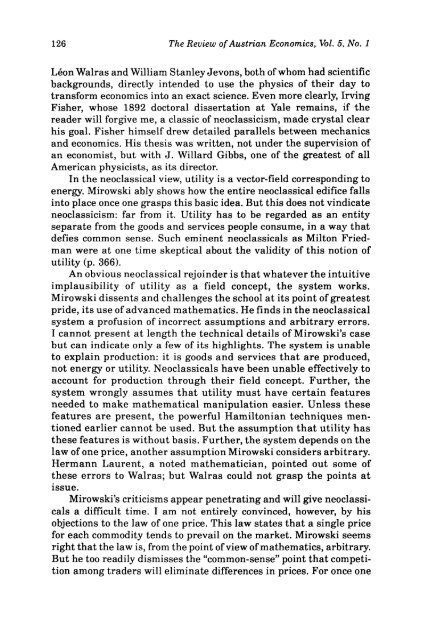Review of Austrian Economics - The Ludwig von Mises Institute
Review of Austrian Economics - The Ludwig von Mises Institute
Review of Austrian Economics - The Ludwig von Mises Institute
Create successful ePaper yourself
Turn your PDF publications into a flip-book with our unique Google optimized e-Paper software.
126 <strong>The</strong> <strong>Review</strong> <strong>of</strong> <strong>Austrian</strong> <strong>Economics</strong>, Vol. 5, No. 1<br />
Leon Walras and William Stanley Je<strong>von</strong>s, both <strong>of</strong> whom had scientific<br />
backgrounds, directly intended to use the physics <strong>of</strong> their day to<br />
transform economics into an exact science. Even more clearly, Irving<br />
Fisher, whose 1892 doctoral dissertation at Yale remains, if the<br />
reader will forgive me, a classic <strong>of</strong> neoclassicism, made crystal clear<br />
his goal. Fisher himself drew detailed parallels between mechanics<br />
and economics. His thesis was written, not under the supervision <strong>of</strong><br />
an economist, but with J. Willard Gibbs, one <strong>of</strong> the greatest <strong>of</strong> all<br />
American physicists, as its director.<br />
In the neoclassical view, utility is a vector-field corresponding to<br />
energy. Mirowski ably shows how the entire neoclassical edifice falls<br />
into place once one grasps this basic idea. But this does not vindicate<br />
neoclassicism: far from it. Utility has to be regarded as an entity<br />
separate from the goods and services people consume, in a way that<br />
defies common sense. Such eminent neoclassicals as Milton Friedman<br />
were at one time skeptical about the validity <strong>of</strong> this notion <strong>of</strong><br />
utility (p. 366).<br />
An obvious neoclassical rejoinder is that whatever the intuitive<br />
implausibility <strong>of</strong> utility as a field concept, the system works.<br />
Mirowski dissents and challenges the school at its point <strong>of</strong> greatest<br />
pride, its use <strong>of</strong> advanced mathematics. He finds in the neoclassical<br />
system a pr<strong>of</strong>usion <strong>of</strong> incorrect assumptions and arbitrary errors.<br />
I cannot present at length the technical details <strong>of</strong> Mirowski's case<br />
but can indicate only a few <strong>of</strong> its highlights. <strong>The</strong> system is unable<br />
to explain production: it is goods and services that are produced,<br />
not energy or utility. Neoclassicals have been unable effectively to<br />
account for production through their field concept. Further, the<br />
system wrongly assumes that utility must have certain features<br />
needed to make mathematical manipulation easier. Unless these<br />
features are present, the powerful Hamiltonian techniques mentioned<br />
earlier cannot be used. But the assumption that utility has<br />
these features is without basis. Further, the system depends on the<br />
law <strong>of</strong> one price, another assumption Mirowski considers arbitrary.<br />
Hermann Laurent, a noted mathematician, pointed out some <strong>of</strong><br />
these errors to Walras; but Walras could not grasp the points at<br />
issue.<br />
Mirowski's criticisms appear penetrating and will give neoclassicals<br />
a difficult time. I am not entirely convinced, however, by his<br />
objections to the law <strong>of</strong> one price. This law states that a single price<br />
for each commodity tends to prevail on the market. Mirowski seems<br />
right that the law is, from the point <strong>of</strong> view <strong>of</strong> mathematics, arbitrary.<br />
But he too readily dismisses the "common-sense" point that competition<br />
among traders will eliminate differences in prices. For once one

















